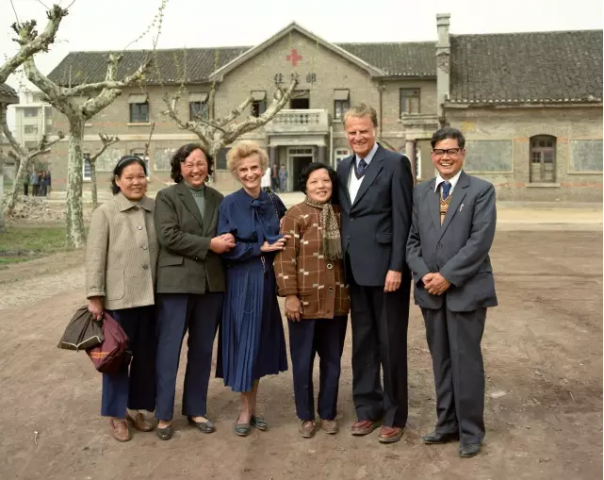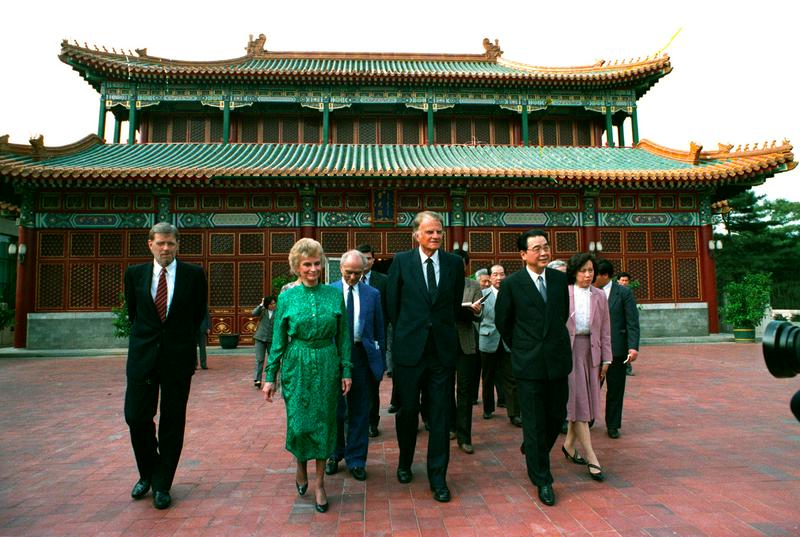Late Saturday, the official Facebook account of Billy Graham remembered 37 years ago when Billy Graham came to China, his wife Ruth's birthplace, the first time.
"On April 12, 1988, what seemed impossible became a reality when Billy Graham and his wife, Ruth Bell Graham, stepped foot in China together," the account wrote.
That day marked the beginning of the great American evangelist's seventeen-day, five-city trip in China. "The Grahams spent a wonderful two and a half weeks in China preaching in churches and schools, meeting with Chinese believers, and visiting Ruth's birthplace in Tsingkiangpu."
Billy Graham recalled in details in his autobiography Just As I Am that this trip came after Bishop K. H. Ting, then president of the China Christian Council (CCC), sent him a preliminary invitation in 1985. Graham wrote in the book, "After a series of negotiations, a firm invitation arrived, asking us to preach in churches in several cities in September of 1987." However, the trip was delayed due to Graham's unexpected rib fracture in Japan and did not take place until April 1988.
Upon their arrival in Beijing, the Grahams were greeted with a red-carpet at the airport by Chinese Ambassador Zhang Wenjin, Bishop K. H. Ting, Han Wenzao, vice-president of CCC, and American Ambassador Winston Lord.
While in Beijing, Graham met Premier Li Peng for 50 minutes in Zhongnanhai, the official compound where Chinese leaders reside near the Forbidden City. "Despite their differing religions, the two engaged in meaningful discussions about spiritual matters," the book said. Premier Li "discussed the potential role for Christians in China's new environment of openness" with Graham and told him that the Chinese constitution "guaranteed freedom of religious belief."
Graham also shared his Christian convictions with high-ranking officials and other religious leaders in Beijing.
Reflecting on the 17-day journey, Graham wrote, "In a span of seventeen days, covering two thousand miles and five major cities, we packed in more speaking and preaching engagements, interviews, social events, and even sightseeing than I remembered from any other trip I'd taken (though not as much sightseeing as I would have liked). He wrote, "Both foreign and American press interviewed us at many stages, but their coverage hardly hinted at the impact all those experiences made on me. Several events remain as special highlights in my memory."
One of the highlights was a meeting at Peking University, which was founded by missionaries. Graham introduced in the book, "…Its first president was Dr. John Leighton Stuart, a missionary who also was the last American ambassador to China before the Communist Revolution."
A significant moment during the trip was the opportunity to preach in numerous churches. "Visiting with Christians who were part of the Three-Self Patriotic Movement, as well as those involved in the unregistered or house churches, I sensed a tremendous spiritual vitality," Graham recalled.
Graham preached in Beijing Chongwenmen Church which used to seat 700 people, but was packed with 1,500 people during his visit. "As I entered, I noticed women kneeling at the altar and praying. Among the crowd at the service was a delegation of ethnic Chinese from Brazil. I urged my listeners to include in China's ambitious modernization program a moral and spiritual renewal as well—or a values system, as I explained to Charles Gibson when he interviewed me via satellite from Beijing on the Good Morning America program. Most of all, I urged them to open their hearts to Christ and His transforming power and love."
In Nanjing, Graham addressed a group of 200 seminarians, whose commitment and ability impressed him. He saw this as "the promise of a spiritual revival in China."
The evangelist also preached at the Moore Memorial Church (also known as Muen Church) and the Pure Heart Church in Shanghai. "In my limited experience, the Chinese congregations were always attentive, with many people taking notes as I spoke. In some churches, I saw people line up at book tables to buy Bibles and other Christian literature."
On April 23, Graham met with Pastor Wang Mingdao, a leading figure China's house church movement. After being released from prison during the Cultural Revolution, Wang "and his wife lived in a humble third-floor apartment on an out-of-the-way street." "Old and thin, he was sitting on a metal chair, asleep, when we arrived, his head on his folded arms resting on the simple kitchen table." Graham remembered, "We stayed at least half an hour, and our conversation was almost completely about the Bible and spiritual things." At the end of the visit, Wang quoted Revelation 2:10 as a word of encouragement.
Another highlight was the visit to Tsingkiangpu (now called Qingjiang), Huai'an, Jiangsu Province. Ruth Bell Graham was born there on June 10, 1920, and lived there until the age of 17. She was called by the Chinese "a daughter of China."
The Grahams visited an "old Presbyterian mission hospital compound" founded "in 1887 by Dr. and Mrs. Absalom Sydenstricker, parents of Pearl Buck." It was the very place where "Ruth was born and spent her childhood and early teen years."
Her medical Presbyterian missionary parents, Dr. Nelson and Virginal Bell, worked in that city, and her father established the Love and Mercy Hospital, then the world's largest Presbyterian hospital and the predecessor of the Second People's Hospital of Huai'an. Having stayed in China for 25 years, the Bells were forced to leave the country due to the Battle of Pearl Harbor in 1941.
"At the local church, seventy-four-year-old pastor Fei Su, who had been there since 1936, told us that as many as 800 attended Sunday services now in the old missionary house of Jim and Sophie Graham, spilling out into the yard." Graham wrote, "Pastor Fei estimated there were 130,000 Christians in that area of the province."
He continued, "On the trip by car to Huaiyin from Lianyungang, we passed through miles and miles of what Ruth called 'old China,' with little villages, mud farmhouses with thatched roofs, ducks, a small pond, water buffalo, and a few chickens. 'I felt at home,' Ruth wrote in her diary. 'I'm sure I have peasant blood in my veins!'"
Graham and the team also visited a three-story building "that held an independent house church" in Guangzhou. "People were crammed everywhere, including on the stairways; three-quarters of them appeared to be young." He gave a short greeting, hoping that his unplanned presence would not cause any trouble to them.
Throughout the trip, Graham began to understand that Christianity in China faced two main challenges: "to become thoroughly Chinese, and thus to become truly, universally Christian" and "to help fill the spiritual vacuum."
Since then, he returned to China in 1992 and 1994, during which he had been "staggered by China's explosive economic growth, with massive traffic jams and skyscrapers under construction." He concluded, "On each visit, my feeling about China's strategic place in the future has been reinforced. We continue to pray for China, that it may become a spiritual powerhouse in the future."













